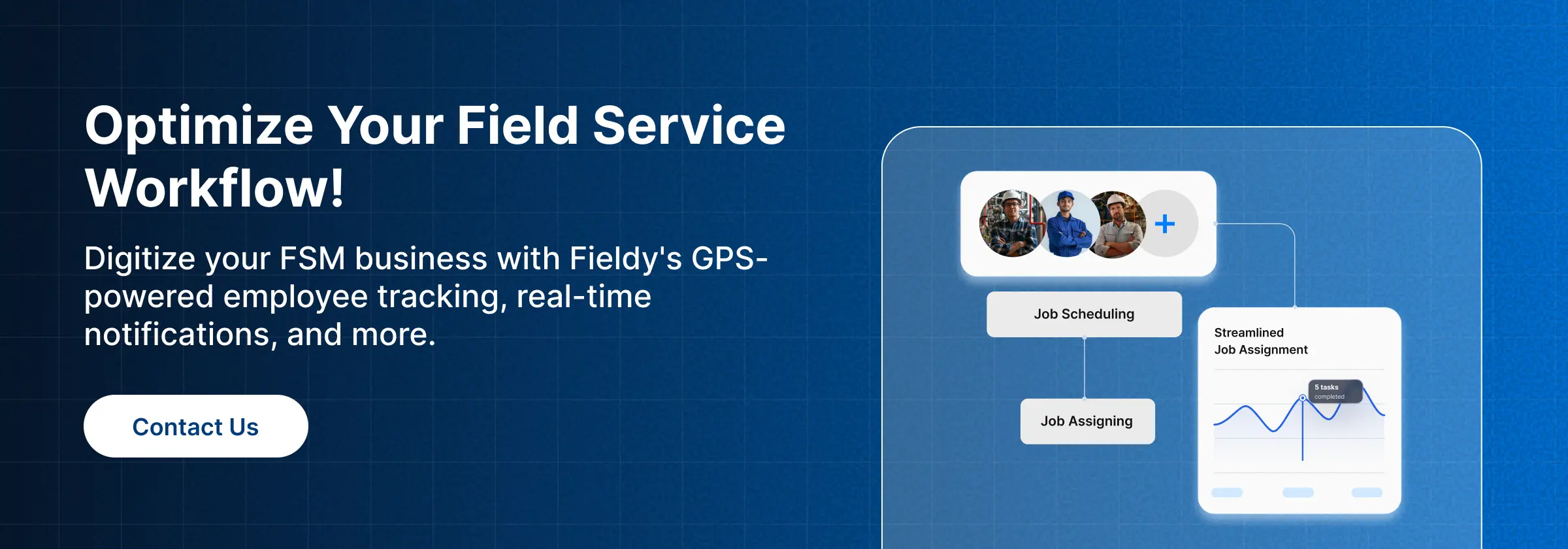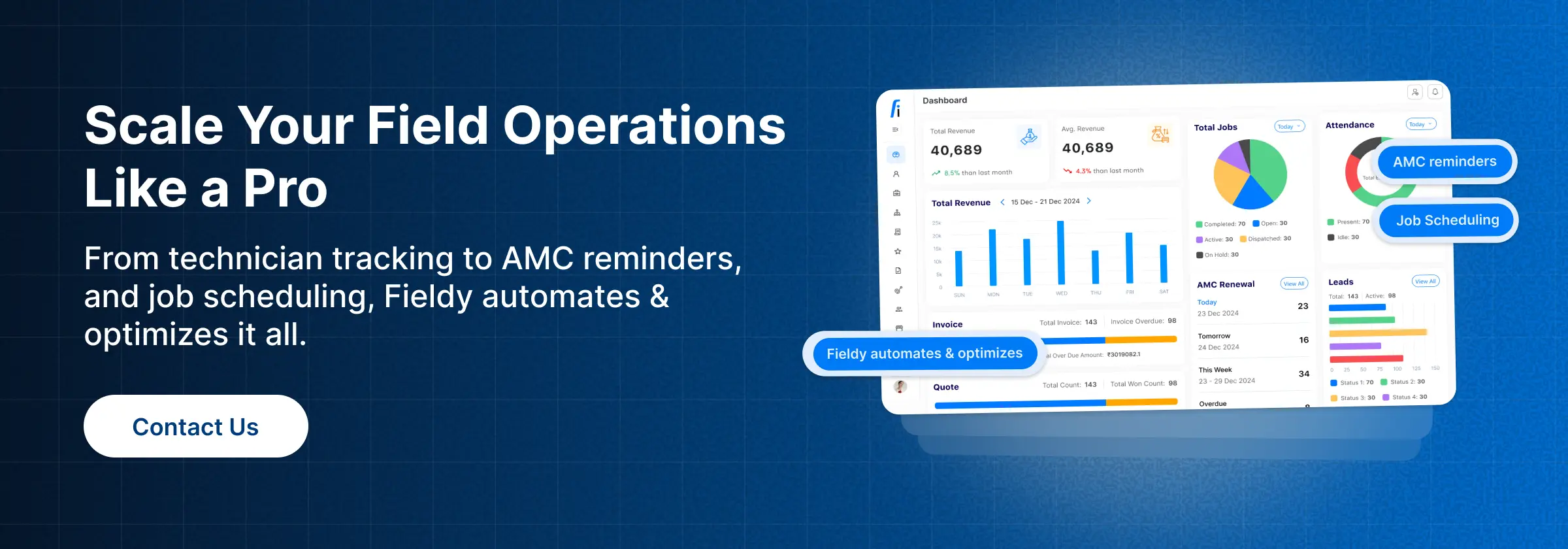📝 Introduction
Growth of revenues is the lifeblood of every field service company. Without constant revenue growth, even nicely run businesses will be typically stagnant as operational costs keep rising and, secondly, competitors are themselves acquiring market shares. Many owners are always looking at trimming expenses. The question, however, really pertains to how we bolster revenue growth in an irreversible and quantifiable manner.
Over the years, Field Service Management (FSM) software has been traditionally reduced to cutting inefficiencies: mapping customer routes between the call and projects, billing through paperless systems, and limiting paperwork. By 2025, however, the focus extends above mere efficiency. Modern FSM programs serve as growth engines by helping sales organizations increase their revenues through better lead conversion, customer retention, and margin enhancement via operational intelligence.
In other words, this then begs the question: would it be considered a good revenue growth rate in field service businesses? The kind of benchmarks varies according to the size of the company:
| 🏢 FSM Company Type | 📈 Good YoY Growth Rate | 📝 Notes |
|---|---|---|
| 🔹 Small FSM firms | 10–20% | Typical for startups/new players scaling fast |
| 🔸 Mid-size firms | 20–30% | High-performing companies with optimized systems |
| 🏢 Enterprise | 10–15% | Lower % growth, but higher absolute revenue |
The takeaway: Sustainable growth, driven by better customer retention and recurring revenue, is more valuable than short-term spikes.
⚙️ How FSM Software Directly Boosts Revenue Growth
FSM software affects revenue by way of several different levers. Let’s look into how it ferries measurable gains:
🎯 Smarter Lead Management ➡️ More Conversions
Lead leakage, the loss of potential jobs due to poor tracking or missed follow-ups, is often the growth bottleneck for a field service business. FSM systems centralize customer data and operate like field service lead generation management software to ensure that every inquiry is logged and nurtured and that follow-up is done automatically.
In 2024, a Texas pest control company adopted CRM-based FSM tools and increased their closed deals by 27% within six months, simply because automated reminders ensured no lead was left unattended.
📑 Faster, Accurate Quoting ➡️ Wins Jobs Quicker
Speed is critical when customers are comparing service providers. Slow or inaccurate quotes are one of the top reasons prospects choose competitors. With built-in proposal templates, FSM platforms enable field service quoting software that generates professional estimates in minutes, not days.
💳 Quick & Easy Invoicing ➡️ Faster Cash Flow
Late payments can suffocate cash flow. With FSM solutions, businesses can issue instant digital invoices the moment a job is completed. Automated reminders further reduce overdue receivables. Companies that adopted field service invoicing software report cutting payment delays by nearly 40%, according to a 2024 FSM Trends Report.
Consider a small electrical services firm in California that shifted to automated invoicing. Their average collection cycle dropped from 35 days to 19 days, improving liquidity and giving them more room to invest in new projects.
💰 Online Payments & Flexible Billing
Today’s customers expect multiple payment options. FSM platforms that integrate online payment features, credit cards, ACH transfers, UPI, and digital wallets, dramatically improve collection rates. Flexible billing cycles (monthly, per-project, or recurring) give customers choice while ensuring steady revenue streams.
⏱️ Time Tracking & Productivity Insights
Every untracked hour is lost revenue. FSM software with real-time digital timesheets helps managers measure technician productivity, analyze job costs, and ensure billable utilization remains high. This isn’t just about oversight, it’s about transparency. Many companies use field service time tracking software to identify inefficiencies and reallocate staff for maximum profitability. ⬇️
🚀 Operational Improvements That Translate to Higher Revenue
Revenue growth doesn’t come from sales alone, it’s also the result of operational efficiency translating into more completed jobs, higher retention, and better margins.
📆 Automated Job Scheduling
FSM tools optimize technician routes and availability, resulting in more jobs per day. For instance, companies using field service scheduling software have reported up to 22% increases in job capacity, according to a 2023 Aberdeen Group study.
🔔 Reduced Missed Appointments
Automated customer reminders cut no-shows and strengthen trust. This directly impacts repeat bookings and loyalty.
📦 Better Inventory Tracking
Running out of parts in the middle of a job is a silent revenue killer. Modern platforms provide real-time tracking of consumables and tools. Insights like those discussed in how to improve employee productivity in field service highlight how inventory visibility drives faster job completion and stronger customer satisfaction.
📊 Key Metrics to Track for Revenue Growth
To measure whether field service management software is delivering revenue impact, companies must track more than just job count. Core KPIs include:
| 📌 Metric | 📖 Explanation |
|---|---|
| 💰 Customer Acquisition Cost (CAC) | The total spend to gain a new customer, including marketing and sales. Lower CAC shows efficient targeting, while higher CAC suggests wasted spend. Tracking it ensures resources are directed to the best channels. |
| 📈 Average Revenue Per Job | The income earned per service call or project. It reflects profitability and can be improved through upselling, premium packages, or accurate digital quoting. |
| 🔄 Repeat Business Ratio | The share of jobs from existing customers. Retained customers are 5–7x cheaper than new ones. A high ratio indicates strong loyalty, while contracts and reminders help increase it. |
| ⏳ Cash Flow Cycle | The time between finishing a job and receiving payment. Shorter cycles mean stronger liquidity. Digital invoicing and online payments help speed collections and sustain growth. |
Tracking these ensures companies don’t just “work harder” but actually work smarter for revenue growth, focusing efforts where they create the greatest long-term impact.
🌱 Best Practices to Achieve Sustainable Revenue Growth
Sustainability matters more than short-lived surges. FSM companies can implement these practices to stabilize and grow revenue year after year:
- 🛠️ Upsell Preventive Maintenance Contracts: Regular service agreements bring predictable cash flow. HVAC companies using this strategy reported 30% higher recurring revenue in 2024.
- 🔄 Automating Renewals: FSM systems auto-generate reminders for expiring contracts, reducing churn.
- 🤝 Training Technicians for Cross-Selling: On-site upsells, air filters, extended warranties, or safety checks, can lift revenue per job.
- 📊 Using Data Analytics for Forecasting: FSM tools predict seasonal demand, helping companies prepare ahead of time. For example, HVAC businesses that know how to track all parts and consumables can keep inventory aligned with peak service months, ensuring technicians are never left waiting on critical items.
Leveraging platforms designed for HVAC operations also strengthens these strategies. Businesses that adopt purpose-built tools gain deeper insights and learn how to increase efficiency using HVAC FSM software, making forecasting and resource planning far more actionable.
🏆 Real-World Use Cases: FSM Software Driving Growth
❄️ HVAC Company Success Story:
A Florida-based HVAC firm increased recurring revenue by 35% after integrating preventive maintenance contracts into their FSM system. Their ability to secure steady work answered the key question of how to increase revenue growth sustainably.
⚡ Electrical Services:
By automating invoices and enabling digital payments, an electrical company reduced its payment lag by 40%, resulting in steadier cash flow.
🚰 Plumbing Business:
A multi-location plumbing contractor scaled efficiently by adopting centralized scheduling and inventory management. They achieved 25% more job completions per technician while maintaining customer satisfaction scores above 90%.
🔚 Conclusion
Revenue growth in field service is no longer about adding more jobs; it’s about running smarter operations powered by technology. From smarter lead management and faster quoting to digital invoicing and predictive analytics, FSM software has become a comprehensive growth engine.
For companies wondering what is a good revenue growth rate, the benchmarks vary, but the path to achieving it consistently lies in modernizing processes and leveraging FSM technology. Those who embrace these tools in 2025 will find themselves not only keeping pace but pulling ahead in a competitive market. ⬇️
❓ FAQs
What is a good revenue growth rate for a field service company?
For small FSM businesses, 10–20% YoY growth is healthy. Mid-sized firms often aim for 20–30%, while larger enterprises typically see 10–15% due to scale but achieve higher absolute revenue.
How does FSM software increase revenue, not just reduce costs?
By accelerating lead conversion, automating quoting, improving invoicing, and enhancing workforce productivity, FSM software generates more revenue opportunities rather than simply cutting expenses.
Can FSM software help with repeat business and long-term customer retention?
Yes. Preventive maintenance contracts, automated renewals, and digital customer reminders all improve retention and increase customer lifetime value.
Which metrics best measure revenue growth for FSM businesses in 2025 and beyond?
The most impactful metrics include customer acquisition cost (CAC), average revenue per job, repeat business ratio, and cash flow cycle.
What industries benefit most from FSM revenue growth strategies?
HVAC, plumbing, electrical, pest control, and telecom are the most common adopters. Any business where technician efficiency and customer trust drive profitability stands to benefit.


